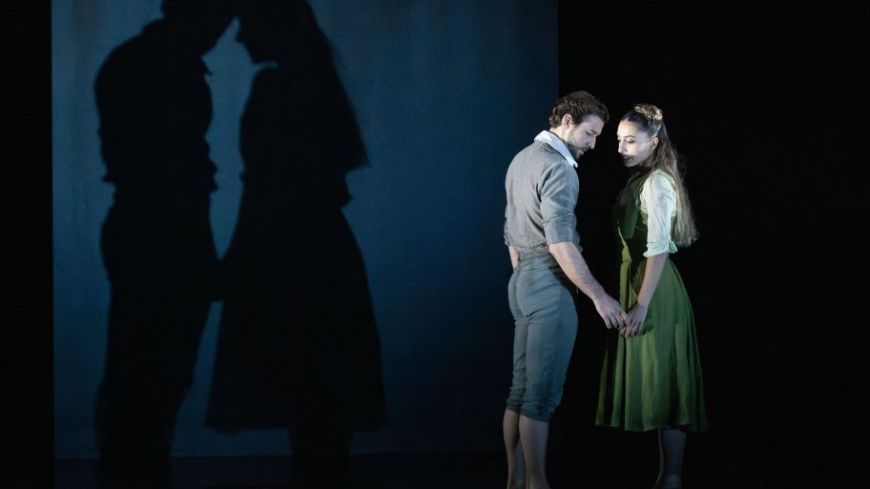
First performed in 2019 to much acclaim, including many award wins and a US tour, Helen Pickett’s striking ballet adaptation of Arthur Miller’s The Crucible reimagines the 1953 classic with a viscerally modern edge, replacing words with movement to tell a story of lust, repression and mass hysteria. Scottish Ballet’s revived production grips the audience from its first haunting moments, where softly chiming bells and dim, crucifix-shadowed lighting immediately plunge us into the oppressive theocracy of 17th-century Salem.
David Finn’s minimalist set design, featuring towering panels that echo the shape of a cross, provides both a literal and symbolic backdrop to the action. His lighting design is a feast of shadows and spotlights, concealing dealings from our eye or starkly amplifying an action which partners beautifully with Emma Kingsbury’s costumes that ground the drama in its Puritan setting; their severity and muted tones highlighting the characters’ internal tensions as well as societal constraints.
Peter Salem (yes, really) is known for great compositions for stage and screen, including Scottish Ballet’s (wonderful) adaptation of Tennessee Williams’ A Streetcar Named Desire. His score here is a dynamic blend of eerie electronics, echoes and sweeping strings that pulse and ebb, underlining each seminal shift in tone, from the adolescent frenzy in the forest to the stark horror of the witch trials, and bolstering Pickett’s dramatic pacing. The orchestra, under Daniel Parkinson, finds nuance in every note, matching the intensity on stage.
Pickett’s choreography breathes physical life into scenes Miller’s text only alluded to, most notably John Proctor’s adultery with the young Abigail Williams. This relationship, central to the ballet’s emotional and narrative propulsion, is rendered through a duet charged with sensuality and emotional conflict. Kayla-Maree Tarantolo’s Abigail is performed with a potent mix of youthful seduction and burgeoning menace, transforming from a smitten girl to the catalyst of chaos, her desire for revenge fuelling this community’s descent into paranoia.
Another key scene brought to stage from only Miller’s description is Abigail and her friends casting spells and dancing around a fire in the woods. Xolisweh Richards’ Tituba, is sensual and welcoming when the young girls join her in the woods, undulating with abandon and freedom despite her slavery and imminent scapegoating. In opposition, Andrea Azzari’s Reverend Parris eludes authoritative fluidity that embraces but also threatens his congregation, which descends into complete jagged horror as he encounters the naked scene, creating a rigid, staccato yet sweeping movement for the Men of God and fuels the manipulated hysteria conjured by the quintet of girls to save themselves.
While the early storytelling is crisp and compelling, particularly in its portrayal of Proctor’s strained marriage, Abigail’s manipulation, and the community joined as one in worship and faith, the second half compresses too much of the remaining plot, muddying the narrative arc in the final quarter. Despite this, the production maintains emotional clarity, thanks to Pickett’s textured choreography and a cast deeply invested in their roles. Bruno Micchiardi brings a raw vulnerability to Proctor amidst the ever growing outrage at injustice, and Jessica Fyfe is dignified and moving as Elizabeth, their first duet a highlight as Micchiardi fervent dance of contrition clashes with Fyfe’s rigid outrage and humiliation that believably changes to affectionate rapprochement tainted with sadness.
On the cusp of perfection, this Crucible remains a fiercely relevant exploration of collective delusion and ideological tyranny that pulses with energy and emotion, anchored by outstanding performances and rich visual storytelling, with works of literature opening the doors to new audiences who can appreciate dance adaptations.
This revival may be rooted in a dark past, but its themes of fear, power and manipulation are uncomfortably current. As a piece of contemporary narrative ballet, this is a searing, stylish triumph.
Scottish Ballet’s The Crucible is at Festival Theatre until Saturday 3 May, then at Theatre Royal, Glasgow from 22 – 24 May.
© Lindsay Corr, May 2025.

